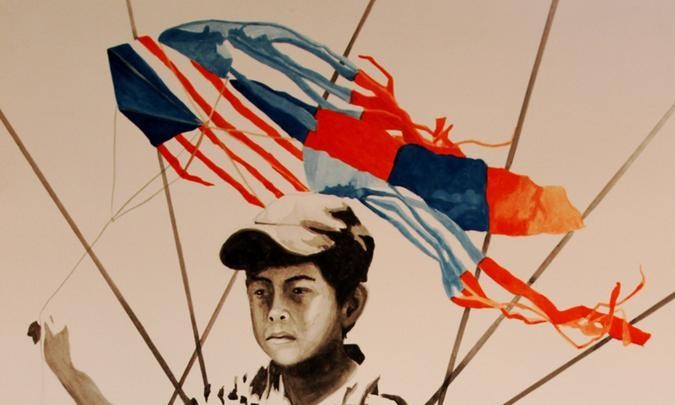Manuel Chavajay & Rebecca Wilcox
14 Nov 2014 - 18 Jan 2015
MANUEL CHAVAJAY & REBECCA WILCOX
This Might Be a Place for Hummingbirds
14 November 2014 — 18 January 2015
Co-curated by Pablo Jose Ramirez and Remco de Blaaij.
As a follow up to the double solo show of Mounira al Solh and Sarah Forrest in 2013, CCA presents two practices that seemingly have no initial links. In an attempt to create a place which interrogates and compares their work, this time Guatemalan artist Manuel Chavajay shares space with Glasgow-based Rebecca Wilcox.
The title refers to the poetic English translation of San Pedro de Laguna, a small village in Guatemala where Manuel Chavajay works and lives.The Spanish name is in turn derived from the local Mayan Tz’utujil language, in effect offering three moments of translation, each encapsulating different forms of exoticism, language and visual heritage.
Invested in questions around how the lived presence of speech might be committed to a form, Rebecca Wilcox considers the approaches and structures that host (artistic) work. Through a lens that gives emphasis to multiple iterations, she looks to an idea of expanded publication as a driving force. Can text or typography become an object through which we understand the current moment? Rebecca Wilcox will explore the spaces and durations in which language and experience coalesce. Manuel Chavajay is an active painter and sculptor. Dealing with local histories of indigenous struggle, he set up a collective that depicts these memories as murals around shops, both uncovering suppressed stories as well as conserving the original language of Tz’utujil, in which many of the texts of the murals appear.
For this show, both artists will exhibit existing work and produce newly commissioned responses that help both of them consider questions of community and approach the translation of urgent issues that arise from societies in Scotland and Guatemala. At such a moment, how successfully can language operate in an arena where potentially violent ideas are being expressed? In an effort to offer a ‘trans-literal’ approach to their concerns and backgrounds, the two artists speculate on how and in which way we can look and speak outwards.
This Might Be a Place for Hummingbirds
14 November 2014 — 18 January 2015
Co-curated by Pablo Jose Ramirez and Remco de Blaaij.
As a follow up to the double solo show of Mounira al Solh and Sarah Forrest in 2013, CCA presents two practices that seemingly have no initial links. In an attempt to create a place which interrogates and compares their work, this time Guatemalan artist Manuel Chavajay shares space with Glasgow-based Rebecca Wilcox.
The title refers to the poetic English translation of San Pedro de Laguna, a small village in Guatemala where Manuel Chavajay works and lives.The Spanish name is in turn derived from the local Mayan Tz’utujil language, in effect offering three moments of translation, each encapsulating different forms of exoticism, language and visual heritage.
Invested in questions around how the lived presence of speech might be committed to a form, Rebecca Wilcox considers the approaches and structures that host (artistic) work. Through a lens that gives emphasis to multiple iterations, she looks to an idea of expanded publication as a driving force. Can text or typography become an object through which we understand the current moment? Rebecca Wilcox will explore the spaces and durations in which language and experience coalesce. Manuel Chavajay is an active painter and sculptor. Dealing with local histories of indigenous struggle, he set up a collective that depicts these memories as murals around shops, both uncovering suppressed stories as well as conserving the original language of Tz’utujil, in which many of the texts of the murals appear.
For this show, both artists will exhibit existing work and produce newly commissioned responses that help both of them consider questions of community and approach the translation of urgent issues that arise from societies in Scotland and Guatemala. At such a moment, how successfully can language operate in an arena where potentially violent ideas are being expressed? In an effort to offer a ‘trans-literal’ approach to their concerns and backgrounds, the two artists speculate on how and in which way we can look and speak outwards.

